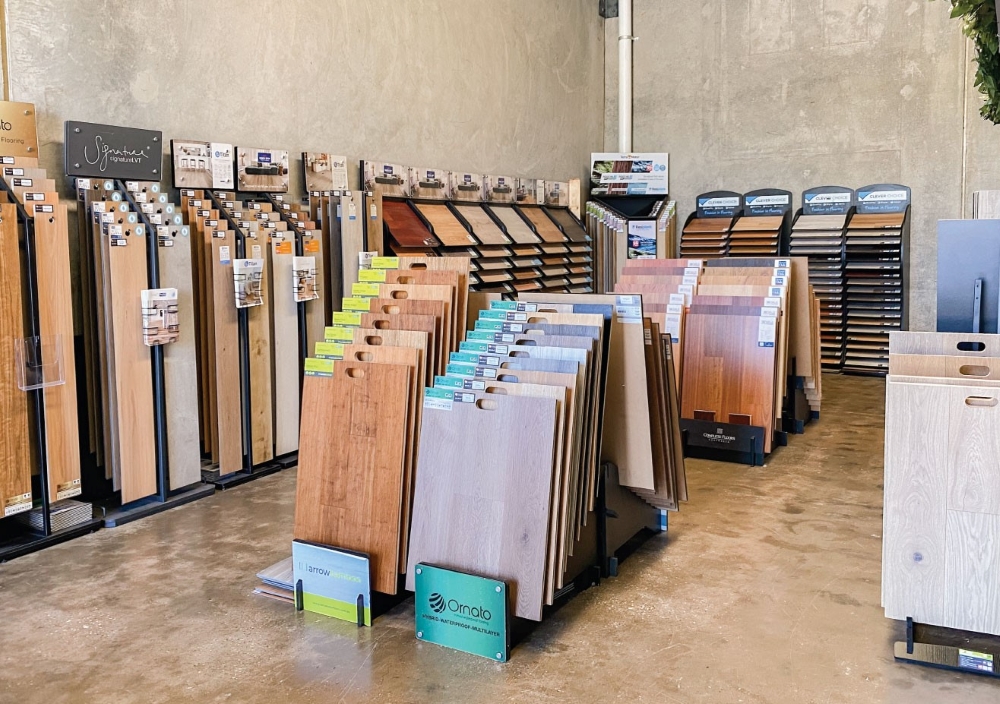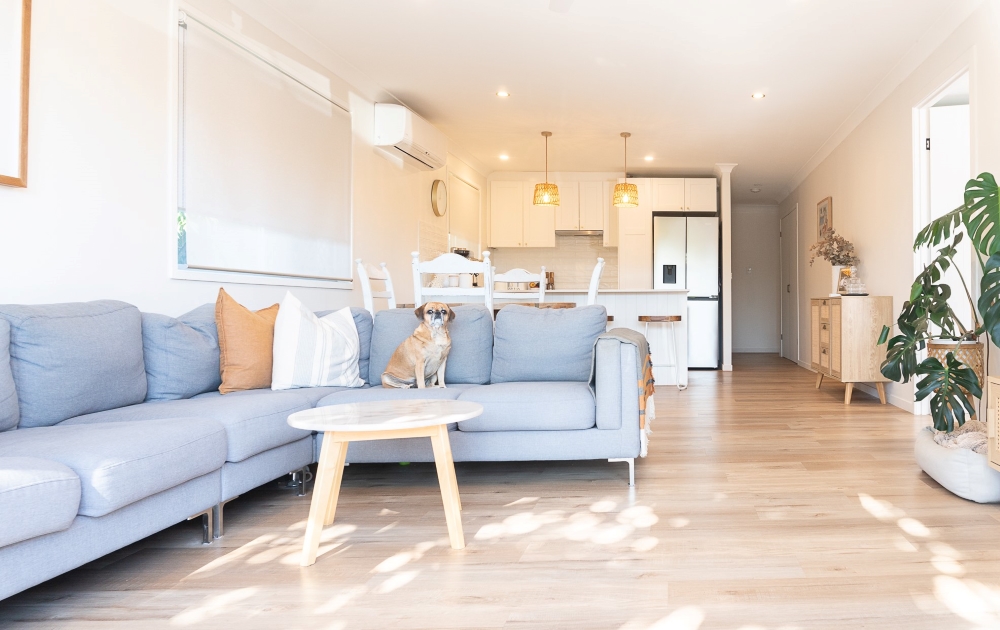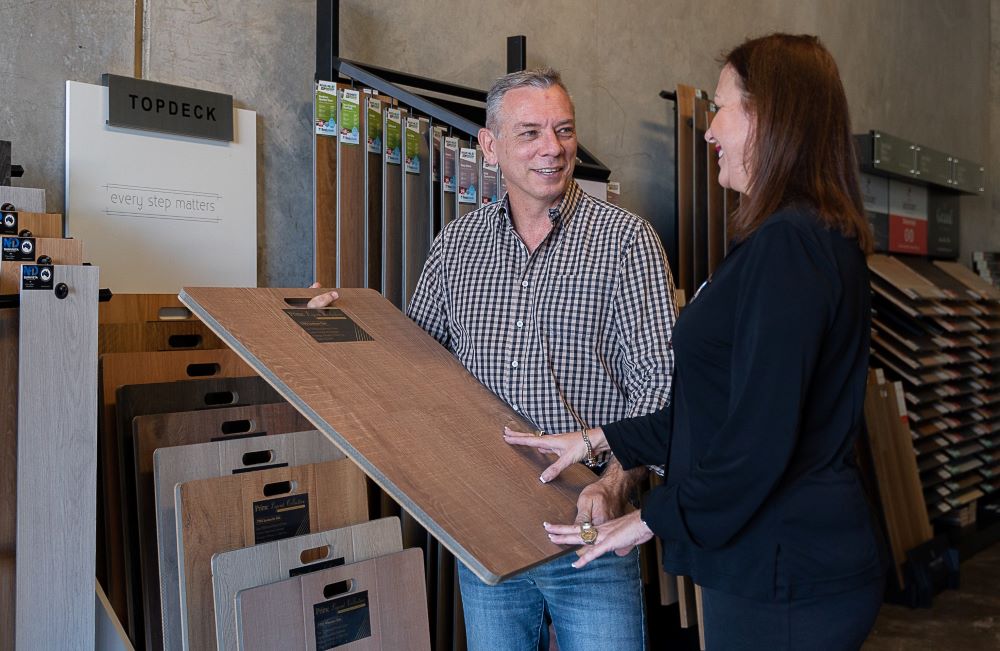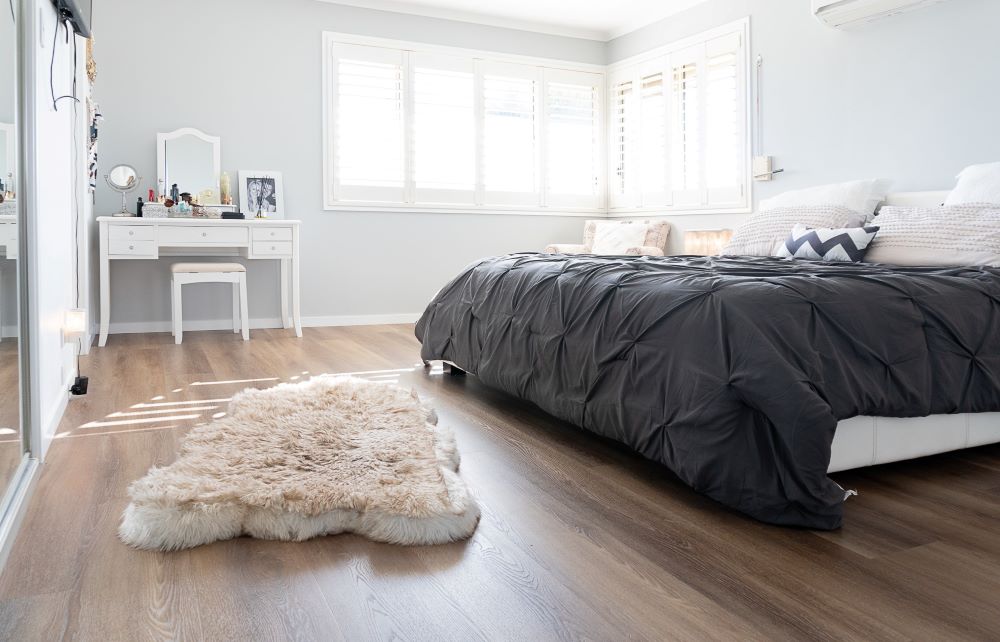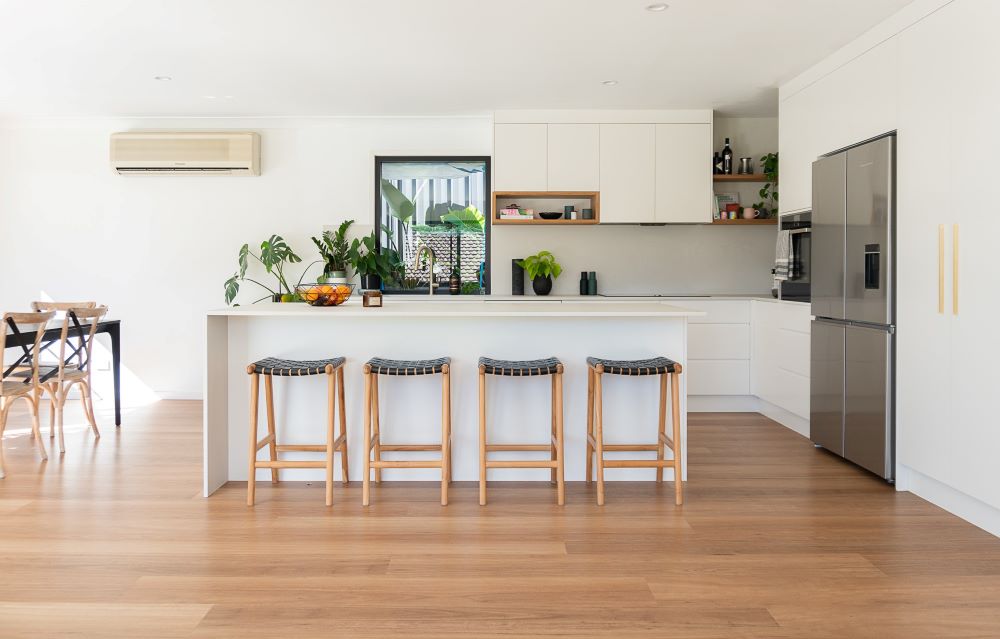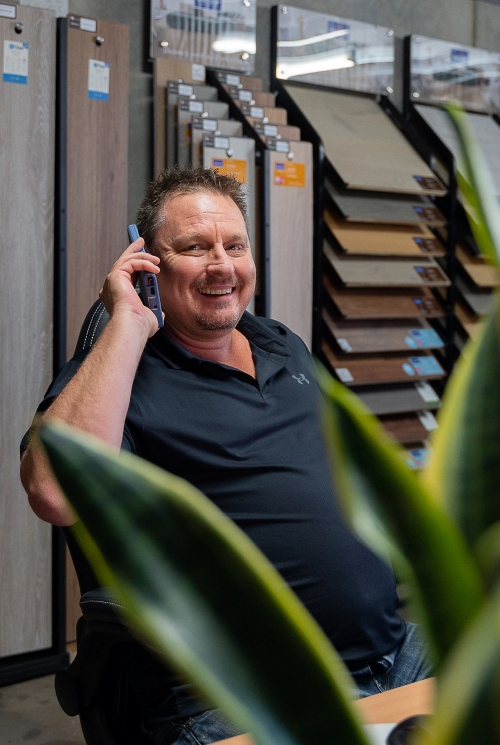Typically, when building a new home, you will have a budget that you will need to be mindful of during the process. Typically though, costs tend to head upward as the project progresses, often leaving you looking for ways to save money toward the end of the process.
Flooring is often the final consideration: the forgotten child if you will. From a building perspective, it often makes sense to leave the flooring to the final stages of the build. From a budget point of view, though, the opposite is true and can cost you far more money in the long term.
When it comes time to decide on the flooring, we often find ourselves strapped for cash. Since flooring is the last thing we do, we often spend as little on it as possible, as we have spent the money elsewhere.
The problem is that the floor is part of the home that endures the most wear, tear and deterioration. It is in the name: Flooring. You walk on it. You stand on it. Your kids drag your couch across it, and your dog tries to dig holes in it. No other part of the home cops this amount of punishment. Yet this is all too often our last priority.
Flooring is an intensely competitive retail market. Most products are not overpriced for the sake of being overpriced. Every product in the industry has to justify its existence in such a competitive battleground. A successful product must generally justify its position in the market within its category and price point.
To answer the overall question, yes, there are compelling reasons why some products are more expensive. To understand this, you need to read a well-researched essay on the topic by experts in the industry.
So we decided to write it.
It is Popular, So Let’s Make It Cheaper to Produce
The evolution of laminate flooring is a classic example of this subject. Laminate Flooring quickly became a popular product for homeowners with great-looking pictures that made an excellent approximation of Timber. To make the product cheaper, much cheaper manufacturers eager to gain market share recognised the picture film was the selling point and the only part that the consumer got to see. So every other element of the product could be of an inferior quality to increase margins for the supplier.
In essence, you can easily create a cheap product that looks good; but for how long? For example, a sub-par wear layer may be cheaper, but a quality wear layer may last twice as long or more. The cheaper wear layer may pass the initial visual inspection, and unless you know what to look for, how would you ever know?
In general, people on a particular budget search for information that supports the choice they have already made based on the price of a product. However, this initial cheap price will cost more when you prematurely replace the product.
An engineered timber is another great example. At the point of sale, if you don’t know the right questions to ask, you may end up with something other than what you are getting. A manufacturer can increase the frequency of Nested (short) boards, lower the visual grading of the veneer, use cheaper coatings and make the product with inferior core materials to reduce the end price of the product. But how do you know this if the salesperson only tells you about the product’s price? Quite often, this is the bit that we want to hear, and then we find out later that there were a few more pieces to the puzzle.
Let’s Expand on Hidden Inferior Materials Using a Hybrid
Let us hijack the blog post momentarily and go down one of our favourite rabbit holes: SPC vs. WPC hybrids. Like laminates, what you don’t see under the surface significantly impacts the product’s performance. Although WPC (aerated core) can still be built well, the fundamental principle of the product makes it vulnerable in certain conditions. Some suppliers have persisted in the sub-category, as this lets them reduce freight costs, which in turn reduces the end price of the product as it goes to market.
Engineered Timber and Its Makeup
Engineered timber is an exciting product category, to say the least. From a sustainability point of view, it’s great, considering hardwoods are slow growing and can take generations to renew, so using a veneer instead of a full, solid natural hardwood board means you can still have a natural product and sustainably cover more space (a lot more space) with a truly natural look. The core of engineered timber can be made using less expensive, easier-to-grow plantation timbers, which take a lot less time to grow. Another added benefit of engineered timber is that bonding the core timber, the rear balancing layer, and the veneer in opposing growth directions can make the product incredibly durable and less susceptible to expansion issues. In essence, clever engineering makes the product greater than the sum of its parts.
The catch is that all of these elements must be of a certain quality and matched to one another. If substandard materials are used, then the entire system can be flawed.

Expert Insights From Raquel Billett
Interior Décor Expert
More prominent companies spend a lot of money on marketing to create brand awareness and have the budget. Based on this alone does not mean a product is any superior to a smaller supplier's products. Sometimes, a high-quality product from a smaller supplier can be a lot cheaper and just as good, and we have always considered this possibility.
Hazardous Materials
Now more than ever, we are conscious of the anatomy of the products we consume and use daily for toxicity reasons. Australia is a very strict marketplace for suppliers, and any product they sell must meet and comply with rigorous standards and rules. The flooring industry is the same, regardless of whether the product is manufactured in Australia or not.
Occasionally, suppliers can be clever with advertising specific points to lure customers in. An example of this is found in Hybrid flooring. When SPC hybrid was first introduced, all products were and still are “pet friendly”. Most companies thought that this was self-evident, so it was not a key point within their advertising. One supplier used this to their advantage by applying “pet-friendly” stickers to all of their products and advertising. Many consumers were swayed by this advertising, even though the product was no different from anything else in the market concerning it being pet friendly!
So how does this apply to everyday customers? Just because someone puts an eco-label on something does not necessarily mean the product is superior to anything else on the market.
It is also far less expensive for a company to create a non-hazardous product than to settle a potential lawsuit. It is good for customers to know these things, but the risk is just too high for a supplier to use any type of hazardous material to make a product cheaper. In the end, it is a false economy for the supplier.
Inferior Workmanship
We break this point into two parts. The workmanship involved the produce the product, and workmanship involved installing the product:
- Producing the product – Typically, a product has to be fit for purpose to enter Australia. This is a pretty broad point and can be argued in several ways. If you are unhappy with how a product looks in a couple of years but has not failed technically, it is still fit for purpose. For a product to be unfit for use, it has to fail to meet its warranty conditions; the supplier would somehow have to compensate the consumer. This situation does, however arise from time to time.
That being said, suppliers still try to find more opportunities to save on manufacturing costs. Money can be saved in any flooring by using generic pressing plates rather than making a product with an Embossed in Register (EIR,) surface. Using cut bevels instead of pressed bevels on laminate is cheaper, but the edge of the product looks less real as there is an epoxy-painted bevel where the picture film of the product is cut away.
- Additionally, floor locking systems are an area where a manufacturer can save money as the licensing agreements on some locking systems are less expensive than others, but this means that the product is often harder to install.
- Regarding product installation – Yes, you can engage with anyone on gumtree, social media groups and directories, but the bottom line is; to be wary of any tradesman who gives you a very cheap quote. In the past, we have seen budget-conscious customers come unstuck with cheap installers, and in some isolated cases, they needed to replace the entire floor. Anyone who does great work will charge what they are worth. A good installer may also mean you need less product because they are less likely to waste product and make mistakes.

Expert Insights From Clem Sturgess
20+ years' experience in hard flooring
As a rule of thumb, we recommend people have at least two boxes of flooring left over so if repairs need to be made, you have the same product and batch on hand to replace a damaged board. If you need to reorder a single box, you will most times have to pay an additional packing fee and extra freight costs for a single one-off item, which are costs that are absorbed over larger quantities.
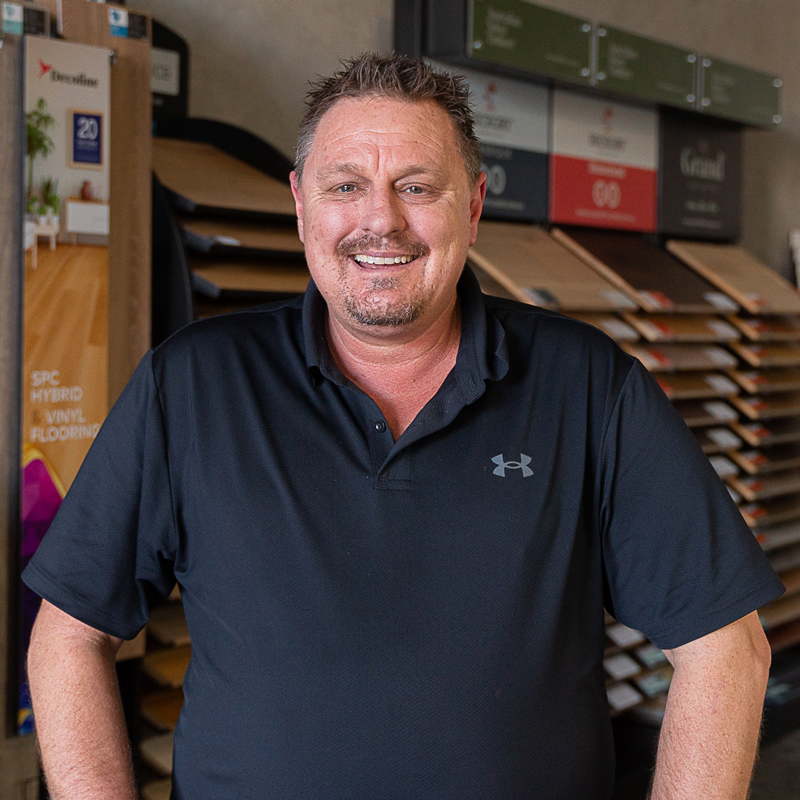
Expert Insights From Dean Billett
28+ Years of flooring industry experience
From a layers point of view, any flooring can become expensive if it is not laid correctly. Cheaper products have their place in the market and can be ideal for many customers, but care must be taken when applying them to the floor. If I were to isolate one category to be wary of in the cheaper realm, it would be laminate becuase some of the cheap core materials can swell up with water and cause huge problems as the seasons pass.
Product Lifespan
We briefly touched on it earlier but felt this needed to be its stand-alone point. In most instances, a better product will not only last longer but will look better for longer as well. Why is this?
Let’s compare two hybrid products to illustrate this point:
- Product A – This is a 5mm product with a 0.3mm wear layer
- Product B – This is a 7mm product with a 0.5mm wear layer
Unbelievably the 0.2mm difference between the wear layers equals a 66% increase on the 0.5mm wear layer over the 0.3mm wear layer. So you increase the longevity of the wear layer by 66%. Additionally, because of the increased protection from this wear layer, it will deteriorate at a far slower rate. Little numbers can make a big difference in the flooring world.
Another example across the board is thinner products with thinner joins are considerably more likely to suffer breaks in the joins when under above-average strain. Although we all know that we must install a product within a supplier’s stated Sub-Floor tolerances, the sad truth is that few people, even the highest-costing big chain retailers, ever do!
Having stronger joins over an uneven subfloor will increase the life of the floor before the inevitable happens. This is not to say that having a thicker product is an excuse for the lack of sub-floor preparation. No such excuse exists. We are simply highlighting the propensity of most consumers to roll the dice where these issues are involved.
One big issue is a product’s deterioration over time and how this affects the product’s overall look. How do we resolve this? Simple. The more you invest now in a better product, the more you will save in the future.
The 0.3mm wear layer product above may still boast a 15-year guarantee but be aware. That guarantee is centred around the product’s lifespan, meaning it may look not so great but still functional at the 5-year mark. Technically speaking, the product has not failed and is in working order. It just looks like rubbish. In comparison, the 0.5mm would have a warranty of more than 25 years (let’s assume the marriage is solid for 20 of those years). It would look better for longer.
The installation costs for both of these products will be the same. One will last and look better for a lot longer. However, once you can no longer stand the look of the tatty product that had the cheap initial price and replaced it, you will have spent more than you would have if you had bought the better product in the first place.

Expert Insights From Dean Billett
28+ Years of flooring industry experience
Expensive hybrids are worth their weight because they are registered embossed (matches the grain image on the print), have better digital printing, and have higher pattern repeats, creating a more natural product. An example of this could be the home feature we supplied Eclipse Stone-Tek hybrid, one of our flagship high-end hybrid products that perfectly mimic solid timber flooring.
Aesthetics
Visual differences are easily noticed between products. The uneducated eye may not instantly know what they are seeing, just that they are seeing it. This is an area where a more expensive product can openly justify itself.
Expensive aesthetic examples in Hybrid:
- The product can have more colours when printing the picture films. More colours mean extra vibrancy and more realism.
- Embossed in registered technology (EIR) – to make a product with an EIR surface is a greater cost to set up because a pressing plate needs to be manufactured for every separate picture film, and this is a huge outlay. A world-class product such as Eclipse Stone Tek will make any regular Hybrid floor put beside it looks like plastic.
- Increased patterns- Decoline’s 7mm hybrid or Terra Mater’s 9.7mm Hybrid floors use multiple picture films meaning they get twice the pattern repeats you would get with other products in the same class.
Repairing Costs
Repairing any rafted flooring, be it hybrid, laminate, or timber presents certain issues. A better-locking system on a board makes it earlier to put together and pull apart. For example, a 5G or 4-sided locking system is much easier to work with during a repair. Tight-fit 2G joins can be very difficult to pull apart once they are engaged, making damage to the product a very real possibility when attempting to disengage individual planks.

Expert Insights From Clem Sturgess
20+ years' experience in hard flooring
Better locking systems are products and used under license. This means anyone can use them provided they are prepared to pay a royalty to the parent company that owns the design, which can also drive the cost of a product upward. These companies protect their intellectual property fiercely!
Replace vs. Renew
Surface renewal only really applies to engineered and natural timber. Concerning engineered timber, the thicker the veneer gives you more latitude in the approach you take with refinishing the product. While products with thicker veneers cost more, you have more room to repair and review scratches, stains and indentations, or even recolour or refinish your product should you choose to.
A micro-veneer timber that has been mistreated will sometimes need to be replaced, as there is not the depth in the timber to give it a second or third life. A thicker veneer while at a greater initial cost, will mean there is room to bring what is a top-shelf product back to life.
Feeling Underfoot & Noise
Feeling underfoot is better determined by the product category itself rather than cost. For instance, a more expensive emboss with a thicker wear layer on a hybrid will feel the same underfoot as a cheaper product with a smaller wear layer.
Top-end hybrids have thicker underlay, with a well-balanced density to the product and will feel more forgiving underfoot.
Water and Moisture Exposure
Using laminate and timber products as an example, their ability to expand directly correlates with the product’s ability to absorb moisture. The less moisture a product absorbs, the less it grows and shrinks. And the fewer problems you have down the track.
If we compare a cheap laminate with a standard fibreboard core to a product like Eclipse Aquaschild, which is completely waterproof and contains resins that protect and incase the core’s fibres. The cheaper product has nothing to protect against moisture, which means the product is susceptible to environmental moisture ingress, water damage and rising dampness from a new slab. Water can enter in various ways with some ways out of your control, and this is where having a cheaper product will hurt. A better product will withstand moisture elements much better.
Buying Out of Fashion
You do not have to be a trendsetter, but you have to see why something offered cheap or at a discount may not be the best option for your space. A product may not be selling for a variety of reasons, so suppliers may often discount a product to create space in their warehouses. That is not to say a product is necessarily defective in any way, but you can’t always force something to fit in and work with your space just because it’s being offered cheaper.
Having unsuitable flooring may decrease the value of your home. The fact is nobody discontinues or discounts a product that is working well for them. Products get discounted to make room for newer or better products because they might be out of trend or there may be slight product flaws the supplier wishes to improve upon.
The bottom line is if someone is discounting something because it is “out of trend”, but it fits your needs perfectly, buy it. If the product has an actual issue, then be very careful.

Expert Insights From Clem Sturgess
20+ years' experience in hard flooring
We had a supplier recently who had a bad batch of vinyl flooring. It was still functional and presentable but sub-par to usual standards. The product was offered at a massively discounted price but with no warranty. Needless to say, we were not interested.
Unstable Colours in Cheaper Products
Many cheaper products do not have UV-stabilized picture films. Put, these products will fade in prolonged direct Australian sunlight. Typically greys go green, browns lighten, and all colours will facade and change. Within a few years, one part of the floor will look nothing like the other.
Professional Installer vs DIY
Tread carefully & pardon the pun. When is DIY achievable? Only you know the answer to this question. It is probably a job you can handle if you are very handy. However, if you don’t know which end of the hammer to strike a nail with then stay away.
If you are good with tools, prepared to have a good go, and have mates that are tradies to help, your chances are you will achieve a good result. This is the kind of thing that boomers used to do. Get the friends around, do the work, and then have some beers and steaks around the BBQ.
Let’s look at a couple of examples of why this might be a good idea:
Example 1 – Having the product installed
Let’s go back to the start and have a look at the 5mm Hybrid with the 0.3mm wear layer (Hybrid A) and the 7mm Product with the 0.5mm Wear Layer(Hybrid B). we will look at an average installation of say 70 square metres of product.
Hybrid A will cost us $34 per m for the product. Hybrid B will cost us $45 for the product. Both of these products, though, will cost us $30 per m for installation.
Our costs are:
- Hybrid A: $34 plus $30 = $60 x 70 metres = $4,200
- HYbrid B: $45 Plus $30 = $75 x 70 metres = $5,250
So Hybrid B costs us an additional $1050 over the cost of Hybrid A. However (and this is a big however,) we can expect 15 years total out of Hybrid A, but at least 25 years out of Hybrid B. As this is a 66% increase in the lifespan of Hybrid B, to find the true cost, we must increase the cost of Hybrid A by 66%. Let’s have a look at the true costs now:
- The true cost of Hybrid A: $6,972
- The true cost of Hybrid B: $5,250
As you can see, our cheap product has become a more expensive option.
Example 2 – Doing the Job Yourself
So you enlist your friends and you grab some meat and bbq rubs for the BBQ and a couple of cases of good beer. We might want to lay the floor first.
We already know the costs of Hybrid A ($34 per m,) and Hybrid B ($45 per m,) but we are going to add Hybrid C, the Eclipse Stone-Tek Hybrid, to the mix at $65 per m. This is an expensive product, right? But it is the strongest, heaviest most realistic-looking Hybrid on the market with the thickest wear layer, thickest underlay, and double the patterns of a Hybrid in the same size. So maybe, just maybe, the cost is justified.
Let’s have a look at the cost of our 3 Hybrids across a 70m job by doing the job ourselves. We will also add a figure of $200 for the beer and Steak.
- Hybrid A: $2,380 + $200 = $2,580
- Hybrid B: $3,150 + $200 = $3,350
- Hybrid C: $4,550 + $200 = $4,750
So you can see that by installing the product yourself you are saving money. However, by installing Hybrid C yourself, not only are you saving $500 over having Hybrid B installed by someone else, but you get the best Hybrid on the market and a great night with your mates around the Barbie! Just make sure they have room to crash at your place afterwards!
Cleaning
In some ways, cheaper flooring can be harder to clean because there is more room for dirt and moisture to enter if a cheaper locking system is used and joins are not airtight.
You will also have to be extremely careful mopping cheap laminate floors. At best, you can use a damp mop to do this. If you compare this to a product like Aqua Guard (a bit of a clue in the name), you can steam mop that product which you cannot do on a cheap laminate.
The same can be said for cheaper timber floors when compared to the Amato timber floor, which is the first to have a waterproof surface. To conclude, the quality of the material in laminate and timber directly relates to how easily you can clean it.
Retailer Reviews
We could only finish a blog on price points by mentioning retailers and reviews. This point, in essence, explains itself. Go with a retailer that customers love and trust and is willing to educate and help guide you to the perfect long-term product for your space.
We live in a referral-based society, and people generally enjoy referring good retailers and service providers. This is an area Online Flooring Store takes great pride in. If you found this blog post helpful, please do not hesitate to leave us a review.


